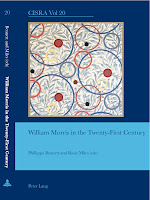New book: William Morris in the Twenty-First Century

Peter Lang has just published William Morris in the Twenty-First Century, an outstanding collection of essays edited by Rosie Miles and Phillippa Bennett and drawn from papers presented at the William Morris Society conference held in London in 2005. The book contains essays from scholars and professionals researching and working in fields relevant to Morris’s diverse interests. The contributors offer a reappraisal of his achievements and influence in areas such as literature, art, architecture, politics, environ- mentalism, science and technology. The essays provide a comprehensive introduction for those new to Morris Studies whilst presenting a series of fresh perspectives for those already familiar with Morris’s work. Phillippa Bennett is Senior Lecturer in English at the University of Northampton. She is Honorary Secretary of the William Morris Society and a member of the Editorial Advisory Board for the Journal of William Morris Studies. . She has published a number of art- icles


